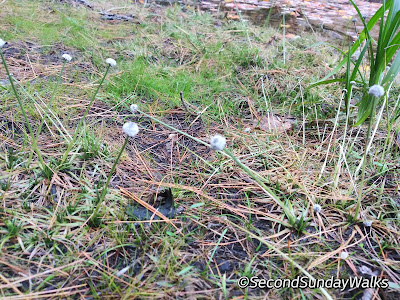We walked a route through a large White Pine forest. The trails aren't especially well marked in the park, but there is a well maintained disc golf course that can be followed. On first entering the forest we looked at red maple leaves and discussed the difference between Red, Sugar, Norway, and Striped Maple leaves. Allen, a nature explorer who often joins us on our walks, found a fuzzy brownish caterpillar with longer black hairs on each end. The group looked to me for an identification, which wasn't coming to me immediately. After spending some time combing my references I've decided it was most likely a Dagger Moth, genus Acronicta, but I'm unsure whether it was A. dactylina (the Fingered Dagger Moth) or A. americana (the American Dagger Moth). I can always count on Allen to find interesting caterpillars. He's a good observer and super knowledgeable about trees. All of the explorers on the Second Sunday Walks are very observant and open to learning and sharing knowledge.
In the forest, we found that many of the ferns had been affected by frost and began turning bleach or brown. One exception was the Evergreen Wood Fern Dryopteris
intermedia. Most of the ferns in the image above are New York Ferns (Thelypteris noveboracensis) There are a few D. intermedia still dark green on the lower left.
Likewise, many mushrooms had reached maturity and begun to decay. While I'm no expert on fungi, I'll only hazard a guess the these may be the remains of Honey Mushroom on the tree trunk, and possibly Broad Gill on the ground. There were still plenty of relatively fresh mushrooms to see too. especially when we explored an area with some decaying Paper Birch trees. Identification yet to be determined, if possible.
| Perenniporia spp.? |
 |
| Possibly a Broad Gill Mushroom Megacollybia platyphylla |
 |
| An old Red Belted Polypore Fomitopsis pinicola found at the base of a tree |
 |
| Possibly a Peppery Milk Cap Lactarius piperatus |
I regret that I didn't have the presence of mind to identify these mushrooms (or the red ones in the upper left of the ring. I did, however, mention that these are formed when the fungi in soil depletes nutrients the ring grows outward forming a progressively larger ring. Some of these fairy rings can be very large indeed, one in France is known to be over 2000 ft and over 700 years old.
Once we reached the lakeside there was plenty to see as well.
We had the opportunity to see Witch Hazel simultaneously ready to disperse this year's seeds and in full bloom with next year's fruit. These seeds are expelled 20 ft when they pop and the flowers are mostly pollinated by moths.
Along the lakeshore we saw Common Pipewort Eriocaulon aquaticum a small plant of lakeshores. We also took notice of the fact that even ferns can display fall colors. Here a Royal Fern Osmunda regalis shows off.
I was asked about this small flower with oddly shaped leaves, which I didn't know. It turns out that it is another plant that seems to favor lakeside settings called Devil's Beggarticks (Bidens frondosa) a nasty sounding name for a nice little plant.
Throughout our walk we made note of the plants growing low to the ground in the forest understory. Pictured above is Goldthread Coptis trifolia a common medicinal herb used for intestinal issues. We also found lots of Partridgeberry Mitchella repens and Teaberry Gaultheria procumbens both used as herbal remedies in their own right. We took note of a couple of common lichens Common Greenshield Lichen (Flavoparmeila caperata) and Crumpled Rag Lichen (platismatia tuckermanii). We also found and briefly talked about sphagnum moss and the ways in which people can identify them.
On our way out of the forest, I stopped to point out what I believe is a large colony of Chicken of The Woods or Sulphur Shelf (Laetiporus sulphueus) although its rotting now, I've seen this colony of mushrooms in my walks here in the past and believe it to be this mushroom.
Organisms identified:
Plants:
Bluebead Lily Clintonia borealis
Canada Mayflower Maianthemum canadense
Starflower Trientalis borealis
Partridgeberry Mitchella repens
Teaberry Gaultheria procumbens
Goldthread Coptis trifolia
Devil's beggarticks Bidens frondosa
Common Pipewort Eriocaulon aquaticum
Evergreen Wood Fern Dryopteris intermedia
New York Fern Thelypteris novaboracensis
Royal Fern Osmunda regalis
Pinesap Monotropa hypopitys
Eastern White Pine Pinus strobus
Eastern Hemlock Tsuga canadensis
Red Maple Acer Rubrum
Striped Maple Acer pennsylvanicum
Sugar Maple Acer saccarum
Yellow Birch Betula alleghaniensis
Paper Birch Betula papyrifera
Witch Hazel Hamamelis virginiana
Lichen:
Common Greenshield Lichen Flavoparmeila caperata
Crumpled Rag Lichen Platismatia tuckermanii
Fungi: Note: Most of these identifications on fungi are unverified.
Honey Mushroom Armillaria mellea
Witches Butter Tremella mesenterica
Red Belted Polypore Fomitopsis pinicola
Sulphur Shelf Laetiporus sulphueus
Peppery Milk Cap Lactifluus piperatus
Broad Gill Megacollybia platyphylla
Perepenniporia spp.
Invertebrates:
Acronicta spp.
Mammals:
Gray Squirrel Scirurus carolinensis
Birds:
Double Crested Cormorant Phalacrocorax auritus
American Crow Corvus brachyrhynchos

















No comments:
Post a Comment